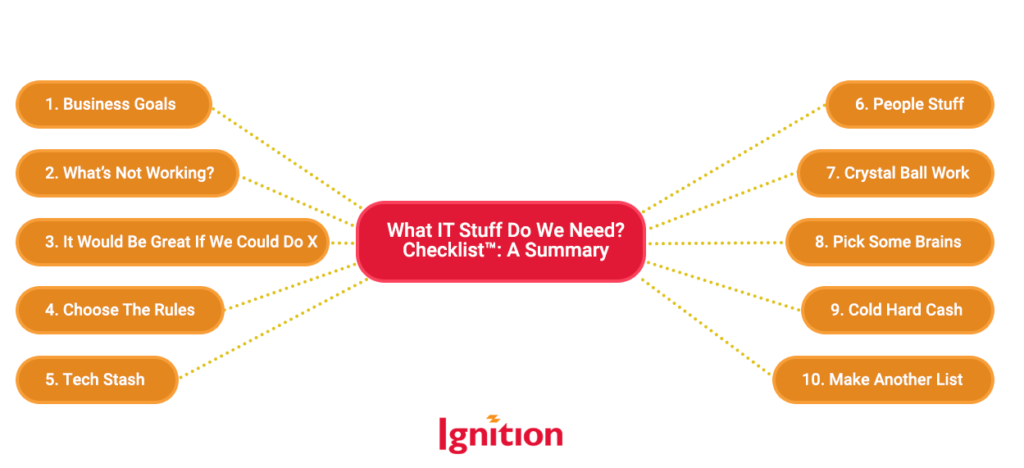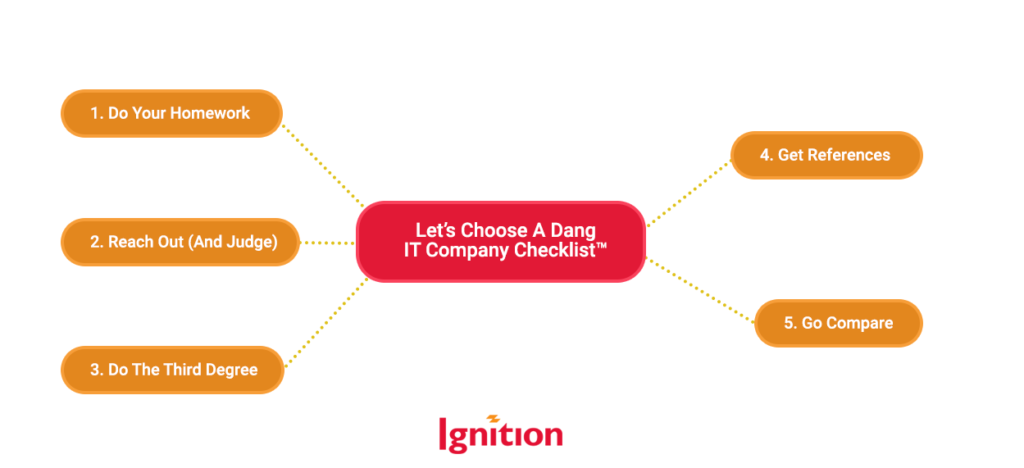Judge not the worth of an IT company by the quality of the cookie basket they send you. There are far more useful metrics, like: Are they good? Do they have the capability to do what you need them to do?
Choosing an IT company that doesn’t suck is only half the battle. The other half is knowing exactly what you need them to do. “We want them to do our IT stuff” won’t cut it. Clarity is key. But what if you don’t quite know what you need, exactly?
In this gripping installment of our “How-To” series, we’ll lob you some handy pointers on how to choose an IT company. Please keep your arms and legs inside the vehicle at all times. Use the bookmarked links to jump ahead.
Trust The Process
Because, yes, it’s a process. Any business decision with the potential to either skyrocket your productivity or throw a slime-covered wrench into it needs a framework (ahem, process) to guide the decision-making. IT, especially, needs careful handling so that once all the shimmyshammying is done, you’ll know that you’ve chosen the right IT company to do the right things. Rejoice!
So, here’s your double-checklisted guide – because who doesn’t love a checklist?* – to take you through the process. We tried to cram our checklists into super-catchy acronyms like CRANULOBIS and SPUZWEE, but it was too hard. Instead, we’ll be using a cheap, low-effort (but highly effective) mind-map format. Double rejoice!
Part I: Identify Your IT Requirements
This part isn’t as easy as it sounds. Yes, you’ll have a clue about what needs fixing, and maybe your new startup buddies in the Leadership Coaching Circle have some shiny new tech that you’re already drooling over. But what’s right for them might not be right for you. Here’s where you whip out your sparkly What IT Stuff Do We Need? Checklist™ and get going.
Your What IT Stuff Do We Need? Checklist™ is an information-gathering tool that – once you’ve checked all the boxes with a satisfying flourish – will give you the required insight to round up and interrogate a bunch of potential IT providers. Then you’ll be ready for Part II.
But first, here’s what’s on your checklist:

Let’s dive in:
1. Business Goals
Here’s where you get all up in your IT strategy. If you don’t got one, don’t panic, because it’s better to start now than not start yesterday. Your business goals will give you a big clue as to what kinds of IT structures and services you need to have in place to support them. Identify your short-term and long-term goals. For instance, are you looking to:
| Get to market, make bank, then get bought by some big, gullible tech corp? Like, super quick? | Sounds like you need fast onboarding, collaborative software, excellent customer service, and a lot of big talk (or roll a nat 20 in Charisma IRL). | |
| Expand your market reach, e.g., by increasing the global headcount to take advantage of new opportunities? | Sounds like you need fast onboarding that’s super secure. In all the languages. | |
| Slash costs, e.g., move to smaller premises or go totally remote? | Sounds like you need mobile device management (MDM). | |
| Get more efficient, e.g., by building a collaborative production process? | Sounds like you need cloud stuff and so-tight-you’ll-bleed security. | |
| Big up your eco credentials to attract green dollars and grants? | Sounds like you need an eco-audit and a brand-new IT procurement strategy. |
Once you’ve thought through your business goals, it’s time to look at the sad stuff: what’s going wrong.
2. What’s Not Working?
Sometimes, it’s obvious that your IT isn’t working for you. Your systems crash, it takes 432 days to set up new remote hires, or HIPAA won’t let you in because you don’t got that thing they need.
But sometimes it’s not obvious – everything’s cool until it hits the fan with a big lump of ransomware, and now your people are locked out of the system. It’s time to list the pain points by actually talking to people. (Innovative, we know.) Ask your team what’s not working for them and what improvements they’d make.
3. It Would Be Great If We Could Do X
Your business goals have given you a clue about what you’ll need from your IT company. But now it’s time to go wild and dream the Big Dream. In this formula, X = recruit from anywhere. Or go fully remote. Or build apps collaboratively in the cloud. Or go greener by reusing spare devices. Or give customers a better online experience.
Write up your wishlist of stuff that would make your business faster/ less hassle/ better than your enemy. Or the IT support that would make your team happier/ less whiny/ super-competent/ not hate you. Go crazy. This list will enrich your vision for the future of your business, which, in turn, will clarify your IT needs.
4. Choose The Rules
This reeks of compliance and may have popped up during your Business Goals thoughts. If you’re aiming for compliance with one, some, or all the compliance frameworks that ever were – like SOC 2, SEC, or the holy of holies, ISO 27001 – then best practices IT that checks all the compliance boxes is what you’ll need. The good news is that IT compliance services are pretty mature, as requirements are well understood.
5. Tech Stash
Take stock of all the IT bits & bobs that you already have: devices, servers, topology, etc., the whole dragon hoard. If you’re pure of heart, you’ll already have an IT asset inventory (and you’re a million percent there with MDM), which you’ll use to find out what’s worth keeping and what should be taken out and shot.
6.People Stuff
Are your people IT-savvy? They don’t have to be Java geniuses spouting alpha-geek techsplurt, but they should know how to spot and report a phishing email. Assess whether your team needs to upgrade their IT smarts. Also – what IT expertise already exists in your business? Choosing an IT company doesn’t mean firing your existing IT people. Often, the sum of your internal team plus external task monkeys is greater than its parts.
7. Crystal Ball Work
It’s time to sit back, relax, and scan the horizon, in terms of what’s new and evolving in IT. Some of this newfangled stuff might be useful for your business. For instance, could evolutions of AI help you do that thing you do faster? Horizon-scanning helps you identify the tech and opportunities that’ll make business better, and gives you a list of future-focused stuff to talk about with a potential IT company. Don’t think you’re qualified enough to scan horizons? Skip to step 8.
8. Pick A Strategic IT Brain or Brains
Time to have an informal chat with a friendly IT expert. Yes, it could be us (*cough*), but it could also be your own tech people or someone else you trust. Ask them about that horizon and what’s coming over it.
9. Cold Hard Cash
It’s time to talk dollars. Here’s where you look at your wishlist, look at your budget, and then weep bitter tears. Or just assess the financials to see what you have to play with, and cut your IT cloth accordingly when you get to Step 10.
10. Make Another List
By now, you’ll be super-informed about your business ambitions, pain points, compliance needs, IT inventory and budget, and the whole heap of what’s going on with your business, IT-wise. Now you have the insight to be able to prioritize your IT projects – what might be most urgent and most aligned with your business goals. What you’ll have is an IT roadmap, and from this, you’ll be able to assess the IT companies out there who specialize in what you’re looking for.
Part II: The Choosing Part
Well done you – you’re halfway there. You’ve established your IT requirements, and that means you have a whole heap of clarity.
But now it’s time for you to take a deep breath and inhale that muffin-and-coffee combo because you’ve still got some hard work ahead. It’s beauty contest time: choosing the IT company of your dreams, not your nightmares. There’s a quick way and a less-quick way:
- Quick way: give us a call (#shameless1)
- Less-quick way: Follow the steps in the Let’s Choose A Dang IT Company Checklist™

1. Do Your Homework
Ask your trusted buddies, colleagues, or LinkedIn contacts for recommendations and referrals. Put in some overtime with your Googling finger by digging into IT companies that look promising. Do they have the right qualifications and compliance accreditations? Check out their websites, case studies, and independent online reviews. Do they have a good Net Promoter Score? For the IT industry, it’s currently sitting around 35. (P.S. Ours is 87. #shameless2.)
Draw up a shortlist of companies that are looking good.
2. Reach Out (And Judge)
Get in touch with your shortlisted companies and judge their responses. Are they quick to reply and proactive in their approach? Do they offer you scripted, cookie-cutter answers, or do you feel seen and loved? Do they communicate clearly, or are you baffled by their response? What’s your gut feeling? You can put a gold star next to the ones that give you the warm fuzzies, but the job isn’t over. It’s time for the third degree.
3. The Third Degree
Nowadays, you don’t need a basement and zip ties to get the truth out because that’s illegal, but don’t be afraid to ask hard questions. Or even easy ones – and judge how they respond. Ask about:
- Past projects
- Challenges they’ve overcome
- How they’d approach your wishlist
Note what questions they ask you – are they truly seeking to understand your business, or do you feel they just want to stuff you with what they can offer? Do they communicate clearly or smokescreen you with techsplurt? How does the cultural fit feel? Do their Service Level Agreements read like ancient Assyrian? Is their pricing structure clear, or is it more like some hellish kind of algebra? What’s their attitude toward data security?
4. Get References
Good IT companies won’t be afraid of giving you the contact details for some of their clients so you can explore firsthand experiences.
5. Go Compare
Once you’ve gathered the information, it’s time to make the choice. Weigh the pros and cons of each of the shortlisted companies. By this stage, your gut might be telling you who’s the favorite, but it pays to be thorough. (Have another muffin. You’re doing great!)
Once you’ve completed this exercise, you’ll hopefully be in a position to feel confident about choosing an IT company that’ll give you the type and level of IT support you need. Go you!
How To Make Choosing An IT Company Super-Easy
First step, give us a call. We don’t bite, and we’re not pushy. We’re honest and authentic because why should business be any other way? It means that if we can’t provide what you need, we’ll tell you (and we’ll recommend a company that can sort you out).
But we’ll bet our collective bottoms that we can get your IT in the shape you need it to be for the fun, sparkly, and profitable future you’re looking for. Let’s have a conversation. And maybe a muffin.
Ignition is Silicon Valley’s best (and friendliest) IT security, compliance, and support team. Contact us now – chatting about IT support and cybersecurity is our favorite thing to do!

